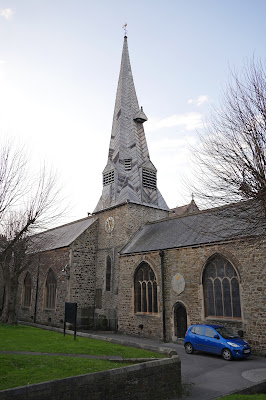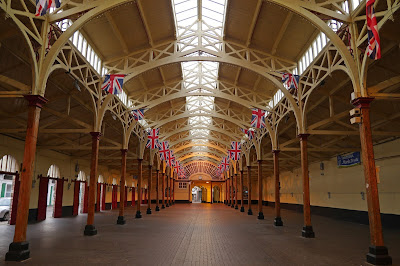The Albert Memorial clock
We are walking the South West Coast Path in the area around Barnstaple and I felt the town was worth a walk around in its own right. I also knew there were several almshouses to see. This walk was a combination of seeing the almshouses and following the town's Heritage Trail (but excluding the river bank as that is covered in our Barnstaple to Braunton Burrows walk). I started at the Albert Memorial Clock (1862 - this was quick work as Albert had died only in December 1861).
From here I walked along Litchdon St in search of the Penrose almshouses. I was struck by this fine, but sadly empty, Victorian building with coloured bricks and ceramic and terracotta tiles - Brannam's Pottery of 1886 by W C Oliver.
The almshouses of 1627 are a little further along the street. They make lovely composition with projecting buildings at the ends joined by a colonade with the main entrance in the middle.
You are welcoem to go in to find a courtyard with a water pump in the middle.
I was told that the caretaker was happy to show people the chapel (the right hand building on the street front) and took the opportunity. The lectern from where the Reader read to the almsfolk from the bible is still present along with a lovely plastered ceiling.
I continued along the street and headed towards the tower of Holy Trinity, a landmark. The church was revealed to be Victorian (1843-5, but partly rebuilt twenty years later). Pevsner describes the interior as dull and I took him at his word and didn't look inside.
I headed back towards the centre of the town along Trinity Street, passing the Salem Almshouses on the right. They were founded in 1834 by Charles Roberts for 24 men and women. There are three ranges, with the street side left open.
On the opposite corner was a small gift shop with exquisite art deco stained glass in the windows.
On the right of the High St I noticed this jolly building with nice stained glass and a sort of loggia at the top.
A bit further on I turned to the right to see the church of St Peter and Paul, with its distinctive tower of the late 12th or early 13th century and twisted spire which was added in 1388-9 (Pevsner).
Just beyond it is St Anne's chapel, an early C14 chantry chapel, now a museum. A chantry chapel was one built on private land, or within a church, endowed in the will of a deceased person). They were abolished at the Dissolution of the Monasteries.
Nearby in the narrow Church St were Paige's Almshouses (1656) and Horwood's Almshouses and School (1674 and 1659 respectively)
Returning to the High St, the next main building was the Guildhall (1826 by local architect Thomas Lee, a pupil of Soane and Lang).
Backing straight onto the Guildhall is the Pannier Market of 1855-6. It is 320 feet long. There are well-known Pannier markets in Bideford, Tiverton, Tavistock and Truro - so it seems to be a Devon thing. But what is a pannier market? According to the Plymouth Council website, the word pannier derived from the French for a basket. So a basket market. This wasn't modern enough for Plymouth who have renamed theirs the City Market.
I now retraced my steps down the High St and turned left into Boutport St to quickly be confronted by the art deco cinema of 1931 by W H Watkins of Bristol. The grotesques at the top of the pilasters are by Eric Aumonier.
Beyond the end of Boutport St is North Road and then Pilton Park. I was now in the suburb of Pilton, once a separate town and possibly older than Barnstaple itself (Pevsner). In Pilton St are the attractive Lower Almshouses dating from 1860.
At the top of the street are the Feoffee Cottages and Church Cottages, a very pretty group with the arch in the centre leading to the church of St Mary, founded in the 12th century and once belonging to Malmesbury Abbey. They date from 1849.
I headed back to the hotel along Under Minnow Road, passing the redbrick Lake Almshouses of 1863, and continuing past Pilton Park via Abbey Road.
Conditions: pleasant late afternoon sunshine.
Distance: perhaps 5 miles.
Rating: four stars. A delightful town, well worth exploring.
















No comments:
Post a Comment